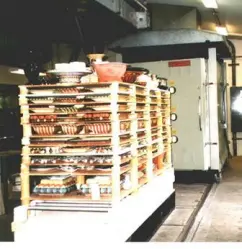Kilns for Traditional Ceramics
Traditional ceramics include tiles, glassware, white ware, dishes and others. Traditional ceramics are derived from naturally-occurring raw materials such as ball clay, glass, quartz or china clay (a.k.a. kaolin, which is used for manufacturing porcelain). Early Chinese kiln designs allowed temperatures above 1000°C, which is essential for sintering porcelain. It was only in 1710, that European potteries achieved higher temperatures in their ceramic kilns thanks to improved refractories, better arrangements for heat circulation, and the introduction of coal for fuel.
By adding additives such as binders, ceramic particles can be formed into desired shapes by extrusion, slip casting, pressing, tape casting, and injection molding. These “green” ceramics then undergo a thermal process (binder removal, hardening treatment = bisque firing, or sintering/calcining) to produce a rigid product. Some ceramic products (i.e., insulators, dinnerware, tiles) then undergo another thermal process, such as glazing. Architectural terra-cotta may be given only a single firing and the glaze is fused or melted onto the surface while the body is hardened. Thin pottery ware would disintegrate if dipped into a bath of glaze before firing. Some grades of porcelain require a bisque treatment at low temperature, just sufficient to harden the body so it will withstand the soaking action of the glaze. The glaze and clay body are then fired to a high temperature and mature together. Clays containing carbonaceous matter require a longer heat treatment during the early period of heating to burn out this carbon content.
Historically, high quality bisque and glazed ware was often fired in saggers (a protective ceramic box) or muffle-type ceramic kilns to protect the ware from the fire and gases. Saggers were also used to help products fired at very high temperatures to hold their shape, especially when the firing process resulted in the formation of a large glassy phase in the product. Bone China is a good example of this use. The use of saggers is declining because of cleaner oxidizing firing with gas, oil, and electric versus firing in a wood or coal firing kiln. The decline is also because of advances in raw materials preparation and forming that allow achieving near theoretical density in the firing without relying on a high percentage of a glassy phase. The sagger method of firing is still used by large potteries, although, in many cases they have changed to more efficient muffle-type tunnel kilns.
Keith’s Advanced Ceramic Furnaces Include:
Contact Keith Company to order a ceramic kiln for your processing needs, or more information on any of our products.






